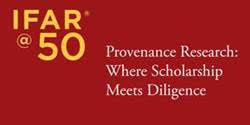Friday, April 21, 2023 -  2023 Interdisciplinary Art Crime Conference,Amelia,Art in War,claims,HARP,Holocaust restitution,Marc Masurovsky,Provenance Research Training Program,World War II
2023 Interdisciplinary Art Crime Conference,Amelia,Art in War,claims,HARP,Holocaust restitution,Marc Masurovsky,Provenance Research Training Program,World War II
 No comments
No comments
 2023 Interdisciplinary Art Crime Conference,Amelia,Art in War,claims,HARP,Holocaust restitution,Marc Masurovsky,Provenance Research Training Program,World War II
2023 Interdisciplinary Art Crime Conference,Amelia,Art in War,claims,HARP,Holocaust restitution,Marc Masurovsky,Provenance Research Training Program,World War II
 No comments
No comments
Summer Course in Provenance Research, Theory and Practice
 |
| Photo taken by Nazi authorities during World War II showing a room filled with stolen art at the Jeu de Paume Museum in Paris |
Recognizing that reclaiming looted cultural assets can feel like a Sisyphean task, and that restitution cannot be accomplished without the practical knowledge of how to conduct critical research, the Association for Research into Crimes against Art (ARCA) and the US-based Holocaust Art Restitution Project, [Inc.] (HARP), have teamed up to offer its 4th annual stand-alone provenance course which tackles the complex issues of cultural plunder.
Course Title: “Provenance and the Challenges of Recovering Looted Assets,”
Course Dates: June 26 - 30, 2023
Course Location: Amelia, Italy
Open to applicants interested in exploring the ownership history of looted cultural objects, their trafficking and their restitution/repatriation, this 5-day course will provide participants with exposure to research methodologies used to clarify and unlock the past history of objects likely to have been displaced in periods of crisis. It will also examine the complex nuances of post war and post conflict restitution and repatriation, as well as its ethical underpinnings.
 This course is taught by Marc Masurovsky, who cofounded HARP in September 1997 and currently serves as its Director of Research.
This course is taught by Marc Masurovsky, who cofounded HARP in September 1997 and currently serves as its Director of Research.
Course Title: “Provenance and the Challenges of Recovering Looted Assets,”
Course Dates: June 26 - 30, 2023
Course Location: Amelia, Italy
 |
| Exhibition in the library of the Collecting Point, summer 1947 © Zentralinstitut für Kunstgeschichte |
Open to applicants interested in exploring the ownership history of looted cultural objects, their trafficking and their restitution/repatriation, this 5-day course will provide participants with exposure to research methodologies used to clarify and unlock the past history of objects likely to have been displaced in periods of crisis. It will also examine the complex nuances of post war and post conflict restitution and repatriation, as well as its ethical underpinnings.
 This course is taught by Marc Masurovsky, who cofounded HARP in September 1997 and currently serves as its Director of Research.
This course is taught by Marc Masurovsky, who cofounded HARP in September 1997 and currently serves as its Director of Research. Since 1980 Marc has examined the general question of assets looted during the Nazi era and has worked as an expert historian on a class-action lawsuit filed by Jewish claimants against three leading Swiss banks, accusing them of having expropriated the property that their families had deposited in their safes and bank accounts.
As a consultant and historian for the Department of Justice's Office of Special Investigations, Masurovsky, has investigated alleged Nazi war criminals living in the U.S. and post-war relations between former Nazi officials and Allied intelligence agencies. Mr. Masurovsky earned his M.A. in Modern European History from American University in Washington, D.C. For his Master's thesis, he researched "Operation Safehaven: the Allied response to Nazi post-defeat planning, 1944-1948". He is also the co-author with Fabrizio Calvi of Le Festin du Reich (Editions Fayard, 2006).
This course will provide participants with the opportunity to engage in an intensive, guided, dynamic exchange of ideas on research methods while highlighting the multiple diplomatic, political and financial challenges raised by restitution and repatriation claims. Special emphasis will also be placed on the contextual framework of provenance research in an era increasingly reliant on digital tools.
With an emphasis on an interdisciplinary and comparative approach, this provenance course will benefit anyone with an interest in art, art history, art collecting, the global art market writ large, museum and curatorial studies, art and international law, national and international cultural heritage policies.
As an added bonus participants accepted into this 5-day course will automatically registered be registered to attend ARCA’s Amelia Conference, the weekend of June 23-25, 2023. This weekend-long forum of intellectual and professional exchange which explores the indispensable role of research, detection, crime prevention and criminal justice responses in combating all forms of art crime and the illicit trafficking in cultural property.
For more information on the course, course fees and how to apply, please see this link.














